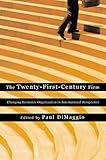The Twenty-First-Century Firm : Changing Economic Organization in International Perspective / ed. by Paul DiMaggio.
Material type: TextPublisher: Princeton, NJ : Princeton University Press, [2009]Copyright date: ©2001Edition: Core TextbookDescription: 1 online resource (288 p.)Content type:
TextPublisher: Princeton, NJ : Princeton University Press, [2009]Copyright date: ©2001Edition: Core TextbookDescription: 1 online resource (288 p.)Content type: - 9780691116310
- 9781400828302
- 338.50905
- HD58.8 .T89 2003
- online - DeGruyter
- Issued also in print.
| Item type | Current library | Call number | URL | Status | Notes | Barcode | |
|---|---|---|---|---|---|---|---|
 eBook
eBook
|
Biblioteca "Angelicum" Pont. Univ. S.Tommaso d'Aquino Nuvola online | online - DeGruyter (Browse shelf(Opens below)) | Online access | Not for loan (Accesso limitato) | Accesso per gli utenti autorizzati / Access for authorized users | (dgr)9781400828302 |
Frontmatter -- Contents -- CHAPTER 1 Introduction: Making Sense of the Contemporary Firm and Prefiguring Its Future -- PART ONE. Portraits from Three Regions -- CHAPTER 2. The Capitalist Firm in the Twenty-First Century: Emerging Patterns in Western Enterprise -- CHAPTER 3. Ambiguous Assets for Uncertain Environments: Heterarchy in Postsocialist Firms -- CHAPTER 4 Japanese Enterprise Faces the Twenty-First Century -- PART TWO. Commentaries -- CHAPTER 5. The Durability of the Corporate Form -- CHAPTER 6. The Future of the Firm from an Evolutionary Perspective -- CHAPTER 7. Firms (and Other Relationships) -- CHAPTER 8. Welcome to the Seventeenth Century -- CHAPTER 9. Conclusion: The Futures of Business Organization and Paradoxes of Change -- References -- Index
restricted access online access with authorization star
http://purl.org/coar/access_right/c_16ec
Students of management are nearly unanimous (as are managers themselves) in believing that the contemporary business corporation is in a period of dizzying change. This book represents the first time that leading experts in sociology, law, economics, and management studies have been assembled in one volume to explain the varying ways in which contemporary businesses are transforming themselves to respond to globalization, new technologies, workforce transformation, and legal change. Together their essays, whose focal point is an emerging network form of organization, bring order to the chaotic tumble of diagnoses, labels, and descriptions used to make sense of this changing world. Following an introduction by the editor, the first three chapters--by Walter Powell, David Stark, and Eleanor Westney--report systematically on change in corporate structure, strategy, and governance in the United States and Western Europe, East Asia, and the former socialist world. They separate fact from fiction and established trend from extravagant extrapolation. This is followed by commentary on them: Reinier Kraakman affirms the durability of the corporate form; David Bryce and Jitendra Singh assess organizational change from an evolutionary perspective; Robert Gibbons considers the logic of relational contracting in firms; and Charles Tilly probes the deeper historical context in which firms operate. The result is a revealing portrait of the challenges that managers face at the dawn of the twenty-first century and of how the diverse responses to those challenges are changing the nature of business enterprise throughout the world.
Issued also in print.
Mode of access: Internet via World Wide Web.
In English.
Description based on online resource; title from PDF title page (publisher's Web site, viewed 30. Aug 2021)


